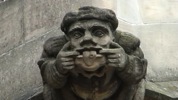…Subtitled: the art and science of remembering everything by Joshua Foer. Or how a young journalist for the Rolling Stone won the US Memory Championship in a year.
Currently on international bestseller lists the cover tells us. Obviously I had to have it. Remembering and forgetting being a favourite pastime.
Josh’s quest is to discover whether we’ve sold our birthright for a bowl of potage. ie our internal memories for an external.
His due diligence in this task leads his book down two paths. First the search for memory techniques and their gradual extinction. Secondly his year long assisted training and accomplishment in winning.
The undisputed guru of modern day memory techniques is Tony Buzan. And the book could almost be sub-subtitled the interview I never got but really wanted from Tony Buzan.
Instead Josh settles on mop haired cane toting mnemomist Ed Cooke, who becomes his guide and mentor. The bible of mnemonists (do you pronounce the initial m as Buzan does)? is Rhetorica Ad Herennium. For those who wish to browse the memory section scroll to number 20.
But the father of memory techniques has to be Simonides and a rather singular event, which happened at a disastrous banquet he attended.
The story:
Simonides was celebrating the same victory with Scopas and his relatives at a banquet when he received word that two young men were waiting outside to see him. When he got outside, however, he discovered firstly that the two young men were nowhere to be found and, secondly, that the dining hall was collapsing behind him. Scopas and a number of his relatives were killed.During the excavation of the rubble of Scopas’ dining hall, Simonides was called upon to identify each guest killed. Their bodies had been crushed beyond recognition but he completed the gruesome task by correlating their identities to their positions (loci in Latin) at the table before his departure. He later drew on this experience to develop the ‘memory theatre’ or ‘memory palace’,
Taken from wiki here
The memory palace arrives in the fifth chapter of Josh’s book. Before that we’ve encountered how difficult it is to find a smart man, the man who remembered too much, the expert on experts and the most forgetful man in the world.
The two basic components of a memory palace are images or that which is to be remembered and places or where it is to be remembered. The person remembering places their image in a certain spot, and animates the image outrageously, so next time he/she walks past the image the remembering happens.
The palace is unique to the person doing the remembering. It can be a structure or a familiar path. As Ed instructs Josh in his first lesson,
‘The thing to understand Josh, is that humans are very, very good at learning spaces’.
as he instructs him on a rock in Central Park on a freezing winter’s day. It’s a very Yoda young Skywalker relationship these two build.
Chapter six should have been my epiphany moment, How to memorize a poem. (he’s a yank. he does zed’s when we all know they should be s’s).
This chapter should be worth the price of the book. I mean 154 sonnets by rote coz i could never figure out how to use Buzan’s method must have some easier way. Right?!
Wrong. As the anonymous writer of ad herennium wrote 2,000 years ago: memorizing poetry and prose is extraordinarily difficult. Well thanks, I knew that. As does Josh, but he follows it with one of my 2 favourite quotes from the book.
“I believe that they who wish to do easy things without trouble and toil must previously have been trained in difficult things.”
The 2nd quote will have to wait as I have a 2nd birthday party of my boy to attend at Tun Fun.

Leave a Reply
You must be logged in to post a comment.